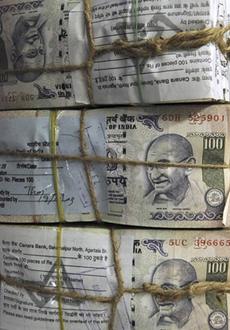India to top global remittances chart with $71 billion inflows in 2013
03 Oct 2013
India is expected to top in global remittances with $71 billion in inward transfers in 2013, nearly three times the FDI it received in 2012, according to a new World Bank forecast.
 The developing world is expected to receive $414 billion in remittances in 2013, with India and China together accounting for $131 billion of the annual transfers, according to a World Bank report.
The developing world is expected to receive $414 billion in remittances in 2013, with India and China together accounting for $131 billion of the annual transfers, according to a World Bank report.
At $414 billion fund transfers, the developing world received 6.3 per cent more remittances over the previous year and the World Bank expects the figure to rise to $540 billion by 2016.
Globally, the world's 232 million international migrants are expected to remit earnings worth $550 billion this year, and over $707 billion by 2016, says the latest issue of the World Bank's Migration and Development Brief.
The top recipients of officially recorded remittances for 2013 are India (with an estimated $71 billion), China ($60 billion), the Philippines ($26 billion), Mexico ($22 billion), Nigeria ($21 billion), and Egypt ($20 billion), the report said.
Other large recipients include Pakistan, Bangladesh, Vietnam and Ukraine.
As a percentage of GDP, the top recipients of remittances, in 2012, were Tajikistan (48 per cent), Kyrgyz Republic (31 per cent), Lesotho and Nepal (25 per cent each) and Moldova (24 per cent).
"These latest estimates show the power of remittances," said Kaushik Basu, senior vice president and chief economist of the World Bank. "For a country like Tajikistan they constitute half the GDP. For Bangladesh remittances provide vital protection against poverty. In terms of volume, India, with $71 billion of remittances, tops the global chart. To put this in perspective, this is just short of three times the FDI it received in 2012," he said.
"Remittances act as a major counter-balance when capital flows weaken as happened in the wake of the US Fed announcing its intention to reign in its liquidity injection programme. Also, when a nation's currency weakens, inward remittances rise and, as such, they act as an automatic stabiliser," Basu said.
In Bangladesh, Nepal, Pakistan and Sri Lanka, remittances are larger than the national foreign exchange reserves. All these countries (most notably, Pakistan) have instituted various incentives for attracting remittances.
In India, remittances are larger than the earnings from IT exports. With the weakening of the Indian rupee, a surge in remittances is expected as non-resident Indians take advantage of the cheaper goods, services and assets back home, with reports of Indian abroad taking loans to remit money back home.
In Latin America and the Caribbean, the growth of remittances has been impacted by the US slowdown. In particular, remittances to Mexico have declined again in recent months, presumably because of a lagged effect of the slowdown in migration flows to the US after the global financial crisis.
In the Middle East and North Africa, displacement of people due to conflict has assumed critical proportions, especially as nearly 2 million Syrians have moved to neighboring countries as refugees. The direction of remittances is unclear.
Remittances to Egypt have nearly tripled since 2009 and is expected, to reach $20 billion in 2013. (Revenue from Suez Canal is now about one-third of remittances).
The World Bank report said the high cost of sending money through official channels continues to be an obstacle to the utilisation of remittances for development purposes, as people seek out informal channels as their preferred means for sending money home.
The global average cost for sending remittances is 9 per cent, broadly unchanged from 2012.
While remittance costs seem to have stabilised, banks in many countries have begun imposing additional 'lifting' fees on incoming transfers, including remittances. Such fees can be as high as 5 per cent of the transaction value.
Some international banks are also closing down the accounts of money transfer operators because of money laundering and terrorism financing concerns, the report noted.





















